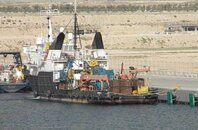CO2 build up would have probably killed them before their O2 supply ran out as the scrubbers on the sunken vessel would have stopped working.
If they were in Saturation on HeO
2 and in shallower water than they were pressurized to, hypothermia would probably kill them first. A shirt-sleeve comfortable temperature at say 300' is around 88° F and they will quickly start to shiver at 80° F. About 50% of your heat lose is through respiration so the core temperature drops very quickly.
They would drown if the diving vessel was in their operational area because the saturation holding depth is shallower than the lockout/working depth. If that was the case, the hatches would open and flood the chambers before the ship settled on the bottom. Purpose-built diving support vessels operating in the North Sea and some other areas require a hyperbaric lifeboat. Unfortunately, they require support people to launch and it sounds like there wasn’t time for that even if they had one onboard.
In any case, blacking out from high CO
2 is miserable and panic-inducing. Hypoxic blackout with normal CO
2 is essentially symptom free beyond loss of consciousness.
There is a
remote chance they could have kept CO
2 down for a while if the bell was mated and they had time for some or all to get in. It wouldn’t have lasted more than 8-12 hours with three people and average onboard emergency battery power, in which case hypothermia would get them.
I hope Scubaboard members Bombay High and Sat Diver weren’t onboard. They do a lot of work in that part of the world. Bombay High was involved in a pretty rough rescue of surface-supplied divers a few months ago.




